Real-Life Traffic Data Based ITS-G5 Channel Load Simulations of a Major Hungarian C-ITS Deployment Site
Abstract
Featured Application
Abstract
1. Introduction
2. Background
2.1. V2X Use Cases and Literature Review
2.2. The Simulation Context
3. The Simulation Environment
3.1. The Simulation Pipeline
- In the traffic data collection stage, we received traffic count data in an hourly resolution from the Hungarian Roads. The data originated from loop detectors which are able to count the passing vehicles. Typically, one loop detector is deployed between each driveway.
- In the traffic data selection stage, we selected traffic scenarios that were considered to represent typical traffic patterns, including, e.g., summer-time low-intensity traffic and school start high-intensity traffic. The selection is elaborated on in Section 4.
- In the traffic data aggregation stage, we calculated the average of the data of the selected road sections in the selected hours. We have also performed some cleaning on the data in this stage.
- In the traffic demand generation stage, we generated the number of entering, leaving, and passing vehicles for each driveway. The method is described in Section 4.
- In the traffic flow generation stage, we generated traffic flows from the previously generated traffic demand values using Algorithm 1.
- In the scenario selection and configuration generation stage, we selected the relevant services and simulation parameters. The configuration is elaborated on in Section 2.
- We used the Artery/OMNeT++ simulator in the supervised simulation stage to model the network and analyze the channel utilization values. The details are described in Section 3.
- We developed data processing scripts to visualize the results in the evaluation stage.
| Algorithm 1 The proposed algorithm for flow generation |
| Require: Demand values to each driveway (D) Ensure: Proper flows (F) F ← {} for all d ← D do l ← d.next {Node satisfy demand} while d.entry ≠ 0 do p ← min{d.entry, l.leaving} {Processable demand} d.entry ← d.entry—p l.leaving ← l.leaving—p F ← F ∪ {d, l, p} {Add flow} l ← l.next end while end for |
3.2. OMNeT++ and Artery-Based Simulation Framework
- The OMNeT++ framework: The OMNeT++ [49] is an event-based discrete-time network simulation framework that serves as a basis for the Artery framework. It is responsible for the simulation core of the network simulator. It also helps with many utility commands, like its own configuration file format, the XML parsing utilities, or the capability of defining multiple configurations with variable parameters.
- SUMO: The SUMO [50]—Simulation of Urban Mobility—is a discrete-time microscopic traffic simulation framework. The SUMO framework supports network files imported from real-world maps using OpenStreetMaps. It is easily configurable with various parameters like the dynamics of the vehicles or the number of cars in a flow. The most important configuration options are the used network files and the route files defining the vehicles or vehicle flows in the simulation.
- INET: The INET framework [51] is practically an open-source simulation model library built on top of the OMNeT++ environment. It implements protocols, agents, and other models for researchers and students working with communication networks. It models and implements various Internet-related protocols like IP, UDP, TCP, Wi-Fi, and many others. The Artery framework uses this library for multiple purposes, like the physical layer implementation.
- Veins: Veins [52] is an open-source framework for executing vehicular network simulations. It integrates INET/OMNeT++ (the event-based network simulator with well-detailed protocol models) and SUMO (the road traffic simulator component). Veins also extends these main components to offer a comprehensive suite of models for inter-vehicle communication.
- Vanetza: Vanetza [53] is an ETSI protocol stack library comprising compiled ASN.1 descriptors. It includes various protocols from the ITS transport, network, security, management, and facilities layers. This package was originally designed to operate on the ETSI-standardized ITS-G5 channels in V2X networks using IEEE 802.11p [54], but it can also be combined with other communication technologies.
- Artery: The Artery framework [55] is considered the state-of-the-art V2X simulation solution to evaluate complete C-ITS service infrastructures based on ETSI ITS-G5 protocols like GeoNetworking and Basic Transport Protocol (BTP). Simulated vehicles can be equipped with multiple V2X interfaces to access various possible ITS-G5 services through Artery’s middleware component that also implements common facilities for the C-ITS services. Furthermore, the framework provides a sensor architecture with local and global environment models and a scripting toolset for dynamically evolving scenarios.
3.3. Proposed Extensions to the Artery Framework
- The CPM support: The Collective Perception Message (CPM) models and the related mechanisms were implemented in our previous work [56]. We further extended and updated this model to a newer version based on the available ETSI CPM standardization documents [57,58]. Apart from that, the dynamic behavior of the protocol—CP service—also had to be implemented in the Artery framework since it is not implemented in Vanetza.
- The modeled V-ITS-S nodes: The Vehicle ITS station (VITS-S) nodes included an ITS-G5 interface to send the status information generated by the vehicles. We have modified the model, enabling the used V2X messages to now be either a Cooperative Awareness Message (CAM) [59], CPM, or CAMs and CPMs in the simulation scenarios.
- In order to enhance the interpretability of the measured data, a data-processing pipeline was developed. In the simulation framework, the proper measurement data were logged. After the simulation, the data were converted to CSV format, which was eventually processed by a Python-based process script based on pandas and matplotlib responsible for the visualization.
- Resource management: The simulation was performed with many simulation setups. The simulation was also time and resource-consuming—both RAM and CPU utilization had to be monitored to achieve optimal speed. To manage this kind of issue, a virtualized docker-based simulation environment was developed. Our ultimate goal is to create a Kubernetes-based simulation system with automatic simulation orchestration and intelligent resource estimation heuristics.
3.4. The Simulation Configuration
4. Traffic Data
4.1. Traffic Data Preprocessing
- Traffic data format: The traffic information provided by road operators is usually the number of vehicles crossing the highway at some measurement points. Contrary to this, the traffic simulators expect the traffic given by routes of cars or vehicle flows. Both of these models expect the start and end positions to be provided. This means that we need to transform the measurement data into some form of a flow model.
- Traffic data: In the phase of traffic data collection, we processed the real-life measured data gathered by Hungarian Public Roads. The data included traffic counter information from various sections of the modeled M0 highway with a one-hour resolution. The data covered three weeks from 2019; one represented winter, one represented spring, and one represented autumn. We split the measurement data into different periods in the day to better showcase the relevant traffic patterns. We took the measurements’ average to calculate the traffic’s magnitude in the specific time period. This means that the measured values of the different intervals are scaled to one hour. After that, we selected periods representing the minimum, the maximum, and the average traffic within that specific day. This method also preserved the typical traffic patterns of that period. The traffic patterns among the measurement points are visible in Figure 3. The S and N letters indicate the direction of the lanes—south or north. The numbers on the X-axis identify the measurement points. The number of vehicles passing the measurement point is represented on the Y-axis.
4.2. Traffic Model
4.3. Transform Data into a Traffic Model
4.4. Obtaining Demand Information
4.5. The Proposed Algorithm to Calculate the Flows
4.6. Generalization of the Solution
5. Measurement Details and Results
5.1. CA Service
5.2. CP Service
5.3. CA and CP Combined Services
6. Conclusions
Author Contributions
Funding
Informed Consent Statement
Data Availability Statement
Conflicts of Interest
References
- C-Roads. The Platform of Armonizedd C-ITS Deployment in Europe. Available online: https://www.c-roads.eu/ (accessed on 26 April 2023).
- C-Roads Brochure. Available online: https://www.c-roads.eu/fileadmin/user_upload/media/Dokumente/C-Roads_Brochure_2021_final_2.pdf (accessed on 26 April 2023).
- CROCODILE Project. Available online: https://crocodile.its-platform.eu/ (accessed on 26 April 2023).
- Szalay, Z. Next Generation X-in-the-Loop Validation Methodology for Automated Vehicle Systems. IEEE Access 2021, 9, 35616–35632. [Google Scholar] [CrossRef]
- Tomaschek, T. Towards Connected and Automated Driving in Hungary–The Changing Role of the Road Operator. In Proceedings of the MAÚT 25 International Scientific Symposium, Budapest, Hungary, 17–18 September 2019. [Google Scholar]
- Commsignia Ltd. Connecting Cars with Each Other and the Smart City Infrastructure. Available online: https://www.commsignia.com/ (accessed on 26 April 2023).
- Varga, A. OMNeT++. In Modeling and Tools for Network Simulation; Wehrle, K., Güneş, M., Gross, J., Eds.; Springer: Berlin/Heidelberg, Germany, 2010. [Google Scholar] [CrossRef]
- Lopez, P.A.; Behrisch, M.; Bieker-Walz, L.; Erdmann, J.; Flotterod, Y.P.; Hilbrich, R.; Lucken, L.; Rummel, J.; Wagner, P.; Wiebner, E. Microscopic Traffic Simulation using SUMO. In Proceedings of the 2018 21st International Conference on Intelligent Transportation Systems (ITSC), Maui, HI, USA, 4–7 November 2018; pp. 2575–2582. [Google Scholar] [CrossRef]
- INET Framework. An Open-Source OMNeT++ Model Suite for Wired, Wireless and Mobile Networks. Available online: https://inet.omnetpp.org/ (accessed on 26 April 2023).
- Sommer, C.; German, R.; Dressler, F. Bidirectionally Coupled Network and Road Traffic Simulation for Improved IVC Analysis. IEEE Trans. Mob. Comput. 2011, 10, 3–15. [Google Scholar] [CrossRef]
- Vanetza. An Open-Source Implementation of the ETSI C-ITS Protocol Suite. Available online: https://www.vanetza.org/ (accessed on 26 April 2023).
- IEEE Standard 802.11-2016; IEEE Standard for Information Technology–Telecommunications and Information Exchange between Systems Local and Metropolitan area Networks–Specific Requirements–Part 11: Wireless LAN Medium Access Control(MAC) and Physical Layer (PHY) Specifications. IEEE: Piscataway, NJ, USA, 2016.
- Riebl, R.; Obermaier, C.; Günther, H.J. Artery: Large Scale Simulation Environment for ITS Applications. In Recent Advances in Network Simulation. EAI/Springer Innovations in Communication and Computing; Virdis, A., Kirsche, M., Eds.; Springer: Cham, Switzerland, 2019. [Google Scholar] [CrossRef]
- Herbert, M.; Váradi, A.; Bokor, L. Modelling and Examination of Collective Perception Service for V2X Supported Autonomous Driving. In Proceedings of the 11th International Conference on Applied Informatics (ICAI), CEUR, Aachen, Germany, 29–31 January 2020; pp. 138–149. Available online: http://ceur-ws.org/Vol-2650/paper15.pdf (accessed on 26 April 2023).
- ETSI TR 103 562 V2.1.1; Intelligent Transport Systems (ITS); Vehicular Communications; Basic Set of Applications; Analysis of the Collective Perception Service (CPS); Release 2. ETSI: Nice, France, 2019.
- ETSI TS 103 300-2 V2.1.1; Intelligent Transport System (ITS); Vulnerable Road Users (VRU) Awareness; Part 2: Functional Architecture and Requirements Definition; Release 2. ETSI: Nice, France, 2020.
- ETSI EN 302 637-2; Intelligent Transport Systems (ITS); Vehicular Communications; Basic Set of Applications; Part 2: Specification of Cooperative Awareness Basic Service—v1.4.1. ETSI: Nice, France, 2019.
- ETSI TS 102 687 V1.2.1; Intelligent Transport Systems (ITS); Decentralized Congestion Control Mechanisms for Intelligent Transport Systems operating in the 5 GHz Range; Access Layer Part. ETSI: Nice, France, 2018.
- Alalewi, A.; Dayoub, I.; Cherkaoui, S. On 5G-V2X Use Cases and Enabling Technologies: A Comprehensive Survey. IEEE Access 2021, 9, 107710–107737. [Google Scholar] [CrossRef]
- Llatser, I.; Michalke, T.; Dolgov, M.; Wildschütte, F.; Fuchs, H. Cooperative Automated Driving Use Cases for 5G V2X Communication. In Proceedings of the 2019 IEEE 2nd 5G World Forum (5GWF), Dresden, Germany, 30 September–2 October 2019; pp. 120–125. [Google Scholar] [CrossRef]
- Correa, A.; Alms, R.; Gozalvez, J.; Sepulcre, M.; Rondinone, M.; Blokpoel, R.; Lucken, L.; Thandavarayan, G. Infrastructure Support for Cooperative Maneuvers in Connected and Automated Driving. In Proceedings of the 2019 IEEE Intelligent Vehicles Symposium (IV), Paris, France, 9–12 June 2019; pp. 20–25. [Google Scholar] [CrossRef]
- He, J.; Tang, Z.; Fu, X.; Leng, S.; Wu, F.; Huang, K.; Huang, J.; Zhang, J.; Zhang, Y.; Radford, A.; et al. Cooperative Connected Autonomous Vehicles (CAV): Research, Applications and Challenges. In Proceedings of the 2019 IEEE 27th International Conference on Network Protocols (ICNP), Chicago, IL, USA, 7–10 October 2019; pp. 1–6. [Google Scholar] [CrossRef]
- Zhang, Z.; Yu, L.; Fan, X.; Li, Y.; Wang, L. A Survey of V2X Testing for Cooperative Connected and Automated Mobility. In Proceedings of the 2021 IEEE 24th International Conference on Computer Supported Cooperative Work in Design (CSCWD), Dalian, China, 5–7 May 2021; pp. 942–946. [Google Scholar] [CrossRef]
- Cinque, E.; Valentini, F.; Persia, A.; Chiocchio, S.; Santucci, F.; Pratesi, M. V2X Communication Technologies and Service Requirements for Connected and Autonomous Driving. In Proceedings of the 2020 AEIT International Conference of Electrical and Electronic Technologies for Automotive (AEIT AUTOMOTIVE), Turin, Italy, 18–20 November 2020; pp. 1–6. [Google Scholar] [CrossRef]
- Antonakoglou, K.; Brahmi, N.; Abbas, T.; Fernandez Barciela, A.E.; Boban, M.; Cordes, K.; Fallgren, M.; Gallo, L.; Kousaridas, A.; Li, Z.; et al. On the Needs and Requirements Arising from Connected and Automated Driving. J. Sens. Actuator Netw. 2020, 9, 24. [Google Scholar] [CrossRef]
- Guerrieri, M.; Mauro, R.; Pompigna, A.; Isaenko, N. Road Design Criteria and Capacity Estimation Based on Autonomous Vehicles Performances. First Results from the European C-Roads Platform and A22 Motorway. Transp. Telecommun. J. 2021, 22, 230–243. [Google Scholar] [CrossRef]
- Lokaj, Z.; Srotyr, M.; Vanis, M.; Broz, J. Technical part of evaluation solution for cooperative vehicles within C-ROADS CZ project. In Proceedings of the 2020 Smart City Symposium Prague (SCSP), Prague, Czech Republic, 25–25 June 2020. [Google Scholar]
- Ribeiro, J.; Moura, L. A-to-Be experience: Deploying a Portuguese highway C-ITS network under C-ROADS Portugal. In Proceedings of the 14th ITS European Congress, Lisbon, Portugal, 18–20 May 2020. [Google Scholar]
- Godarzi, F.; Reiff, T.; Cheung, S.; Hirschberger, M.; Pei, Y. C-Roads Germany. TRA 2020. In Proceedings of the 8th Transport Research Arena, Helsinki, Finland, 27–30 April 2020. [Google Scholar]
- Liu, Y.; Wang, Z.; Li, Y.; Zhou, X.; Ma, C.; Pan, D. V2X-based forward collision avoidance algorithm considering target multi-front vehicles interaction risk. SPIE 2023, 12642, 1264222. [Google Scholar]
- Liu, Y.; Wang, X.; Zhang, Y.; Wang, Y. An effective target selection method for forward collision on a curve based on V2X. In Proceedings of the 2022 7th International Conference on Intelligent Informatics and Biomedical Science (ICIIBMS), Nara, Japan, 24–26 November 2022; Volume 7. [Google Scholar]
- Ma, J.; Li, J.; Huang, H. Evaluation of Multimodal and Multi-Staged Alerting Strategies for Forward Collision Warning Systems. Sensors 2022, 22, 1189. [Google Scholar] [CrossRef] [PubMed]
- Wu, Q.; Zhou, S.; Pan, C.; Tan, G.; Zhang, Z.; Zhan, J. Performance analysis of cooperative intersection collision avoidance with c-v2x communications. In Proceedings of the 2020 IEEE 20th International Conference on Communication Technology (ICCT), Nanning, China, 28–31 October 2020. [Google Scholar]
- Wang, R.; He, F.; Gan, B. Anti-Collision Warning Algorithm of Vehicle Intersection Based on V2X. In Proceedings of the 7th International Conference on Cyber Security and Information Engineering, Brisbane, Australia, 23–25 September 2022. [Google Scholar]
- Ni, Y.; Wang, S.; Xin, L.; Meng, Y.; Yin, J.; Sun, J. A V2X-based Approach for Avoiding Potential Blind-zone Collisions between Right-turning Vehicles and Pedestrians at Intersections. In Proceedings of the 2020 IEEE 23rd International Conference on Intelligent Transportation Systems (ITSC), Rhodes, Greece, 20–23 September 2020. [Google Scholar]
- Chochliouros, I.P.; Spiliopoulou, A.S.; Kostopoulos, A.; Agapiou, G.; Lazaridis, P.; Zaharis, Z.; Chen, T.; Dardamanis, A.; Kourtis, M.A.; Agapiou, M.; et al. C-V2X Communications for the Support of a Green Light Optimized Speed Advisory (GLOSA) Use Case. J. Telecommun. Inf. Technol. 2021, 2, 93–106. [Google Scholar] [CrossRef]
- Wágner, T.; Ormándi, T.; Tettamanti, T.; Varga, I. sPaT/MAP V2X communication between traffic light and vehicles and a realization with digital twin. Comput. Electr. Eng. 2023, 106, 108560. [Google Scholar] [CrossRef]
- Klöppel-Gersdorf, M.; Grimm, J. Evaluating suitable glosa-algorithms by simulation considering realistic traffic conditions and v2x-communication. Transp. Telecommun. 2020, 21, 303–310. [Google Scholar] [CrossRef]
- Aznar-Poveda, J.; Egea-López, E.; García-Sánchez, A.-J.; García-Haro, J. Advisory Speed Estimation for an Improved V2X Communications Awareness in Winding Roads. In Proceedings of the 2020 22nd International Conference on Transparent Optical Networks (ICTON), Bari, Italy, 19–23 July 2020. [Google Scholar]
- Zhang, Y.; Carballo, A.; Yang, H.; Takeda, K. Perception and sensing for autonomous vehicles under adverse weather conditions: A survey. ISPRS J. Photogramm. Remote Sens. 2023, 196, 146–177. [Google Scholar] [CrossRef]
- Vaidya, B.; Kaur, P.P.; Mouftah, H.T. Provisioning road weather management using edge cloud and connected and autonomous vehicles. In Proceedings of the 2021 International Wireless Communications and Mobile Computing (IWCMC), Harbin, China, 28 June–2 July 2021. [Google Scholar]
- Romeo, F.; Campolo, C.; Molinaro, A.; Berthet, A.O. DENM repetitions to enhance reliability of the autonomous mode in NR V2X sidelink. In Proceedings of the 2020 IEEE 91st Vehicular Technology Conference (VTC2020-Spring), Antwerp, Belgium, 25–28 May 2020. [Google Scholar]
- Wippelhauser, A.; Edelmayer, A.; Bokor, L. A Declarative Application Framework for Evaluating Advanced V2X-Based ADAS Solutions. Appl. Sci. 2023, 13, 1392. [Google Scholar] [CrossRef]
- Campolo, C.; Molinaro, A.; Berthet, A.O.; Vinel, A. On latency and reliability of road hazard warnings over the cellular V2X sidelink interface. IEEE Commun. Lett. 2019, 23, 2135–2138. [Google Scholar] [CrossRef]
- Maglogiannis, V.; Naudts, D.; Hadiwardoyo, S.; van den Akker, D.; Marquez-Barja, J.; Moerman, I. Experimental V2X evaluation for C-V2X and ITS-G5 technologies in a real-life highway environment. IEEE Trans. Netw. Serv. Manag. 2021, 19, 1521–1538. [Google Scholar] [CrossRef]
- Selvaraj, A.K.; Beni, P.S.; Shakila, B.; Shenbaga, M.R.; Ankur, D.; Mamoon, R. V2X-Based Highly Reliable Warning System for Emergency Vehicles. Appl. Sci. 2023, 13, 1950. [Google Scholar] [CrossRef]
- Weinert, F.; Düring, M.; Bogenberger, K. Influence of Emergency Vehicle Preemption on Travelling Time and Traffic Safety in Urban Environments enabled by Innovative Behavioral Models and V2X Communication–Simulation and Case Study. In Proceedings of the 2019 IEEE Intelligent Transportation Systems Conference (ITSC), Auckland, New Zealand, 27–30 October 2019. [Google Scholar]
- Ashish, A.; Gandhiraj, R.; Panda, M. V2X Based Emergency Corridor for Safe and Fast Passage of Emergency Vehicle. In Proceedings of the 2021 12th International Conference on Computing Communication and Networking Technologies (ICCCNT), Kharagpur, India, 6–8 July 2021. [Google Scholar]
- Brož, J.; Tichý, T.; Angelakis, V.; Bělinová, Z. Usage of V2X Applications in Road Tunnels. Appl. Sci. 2022, 12, 4624. [Google Scholar] [CrossRef]
- Gelbal, S.Y.; Cantas, M.R.; Guvenc, B.A.; Guvenc, L. Virtual and Real Data Populated Intersection Visualization and Testing Tool for V2X Application Development. arXiv 2023, arXiv:2306.00157. [Google Scholar]
- Zoghlami, C.; Kacimi, R.; Dhaou, R. A study on dynamic collection of cooperative awareness messages in v2x safety applications. In Proceedings of the 2022 IEEE 19th Annual Consumer Communications & Networking Conference (CCNC), Las Vegas, NV, USA, 8–11 January 2022. [Google Scholar]
- Marroquin, A.; To, M.A.; Azurdia-Meza, C.A.; Bolufé, S. A General Overview of Vehicle-to-X (V2X) Beacon-Based Cooperative Vehicular Networks. In Proceedings of the 2019 IEEE 39th Central America and Panama Convention (CONCAPAN XXXIX), Guatemala City, Guatemala, 20–22 November 2019. [Google Scholar]
- Thandavarayan, G.; Sepulcre, M.; Gozalvez, J. Analysis of Message Generation Rules for Collective Perception in Connected and Automated Driving. In Proceedings of the 2019 IEEE Intelligent Vehicles Symposium (IV), Paris, France, 9–12 June 2019; pp. 134–139. [Google Scholar] [CrossRef]
- Delooz, Q.; Willecke, A.; Garlichs, K.; Hagau, A.-C.; Wolf, L.; Vinel, A.; Festag, A. Analysis and evaluation of information redundancy mitigation for v2x collective perception. IEEE Access 2022, 10, 47076–47093. [Google Scholar] [CrossRef]
- Schiegg, F.A.; Brahmi, N.; Llatser, I. Analytical performance evaluation of the collective perception service in C-V2X mode 4 networks. In Proceedings of the 2019 IEEE Intelligent Transportation Systems Conference (ITSC), Auckland, New Zealand, 27–30 October 2019. [Google Scholar]
- Huang, H.; Li, H.; Shao, C.; Sun, T.; Fang, W.; Dang, S. Data redundancy mitigation in V2X based collective perceptions. IEEE Access 2020, 8, 13405–13418. [Google Scholar] [CrossRef]
- Delooz, Q.; Festag, A. Network load adaptation for collective perception in V2X communications. In Proceedings of the 2019 IEEE International Conference on Connected Vehicles and Expo (ICCVE), Graz, Austria, 4–8 November 2019. [Google Scholar]
- Nichting, M.; Heß, D.; Schindler, J.; Hesse, T.; Köster, F. Space time reservation procedure (STRP) for V2X-based maneuver coordination of cooperative automated vehicles in diverse conflict scenarios. In Proceedings of the 2020 IEEE Intelligent Vehicles Symposium (IV), Las Vegas, NV, USA, 19 October–13 November 2020. [Google Scholar]
- Correa, A.; Avedisov, S.S.; Sepulcre, M.; Sakr, A.H.; Molina-Masegosa, R.; Altintas, O.; Gozalvez, J. On the Impact of V2X-based Maneuver Coordination on the Traffic. In Proceedings of the 2021 IEEE 93rd Vehicular Technology Conference (VTC2021-Spring), Helsinki, Finland, 25–28 April 2021. [Google Scholar]
- Maksimovski, D.; Festag, A.; Facchi, C. A survey on decentralized cooperative maneuver coordination for connected and automated vehicles. In Proceedings of the 7th International Conference on Vehicle Technology and Intelligent Transport Systems, Online, 28–30 April 2021. [Google Scholar]



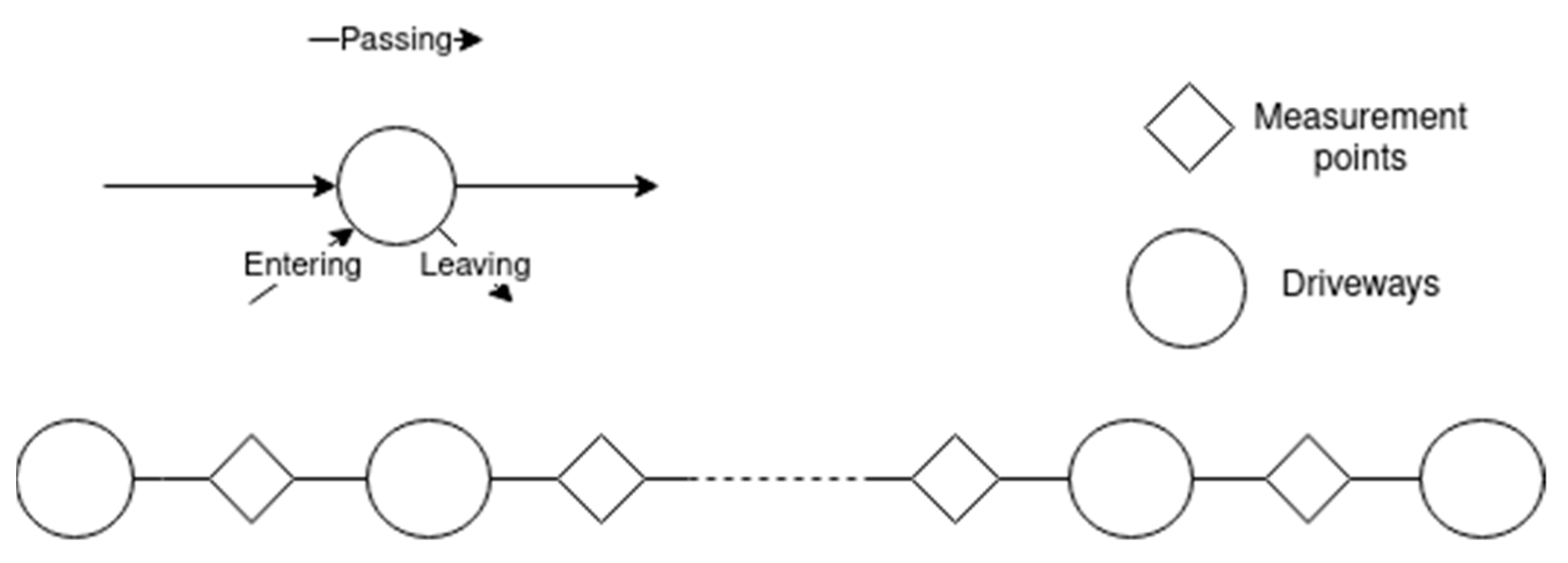

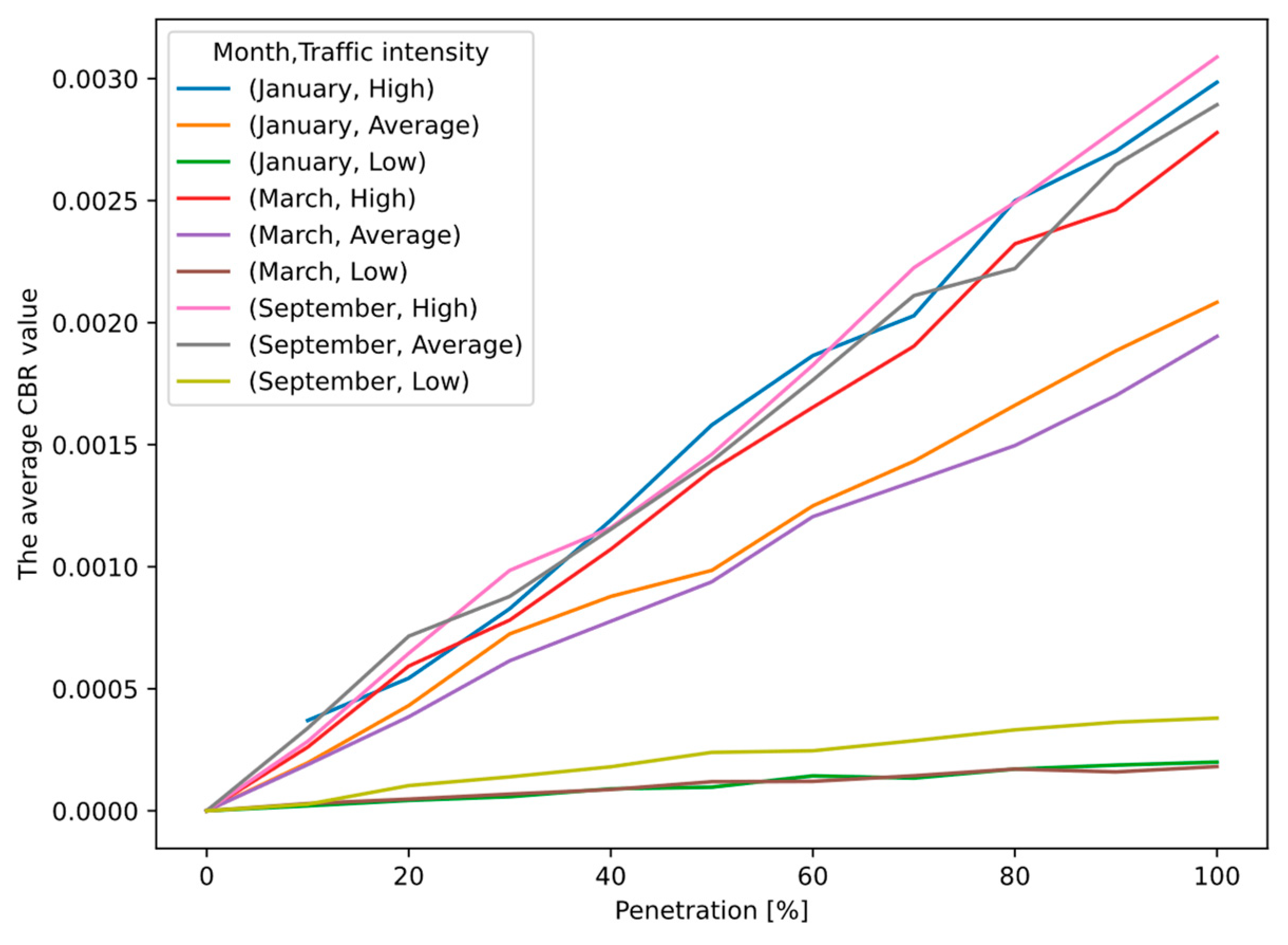
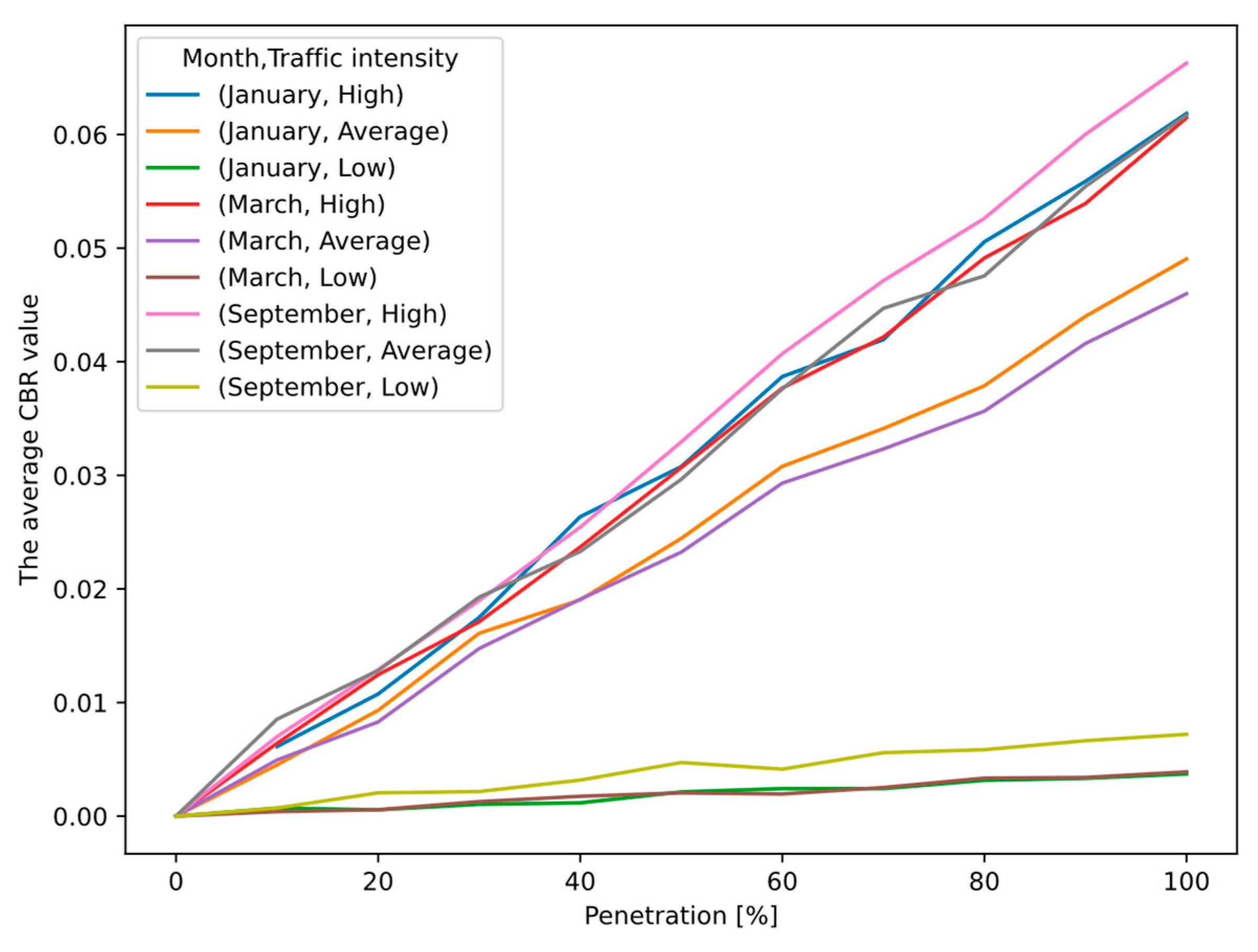

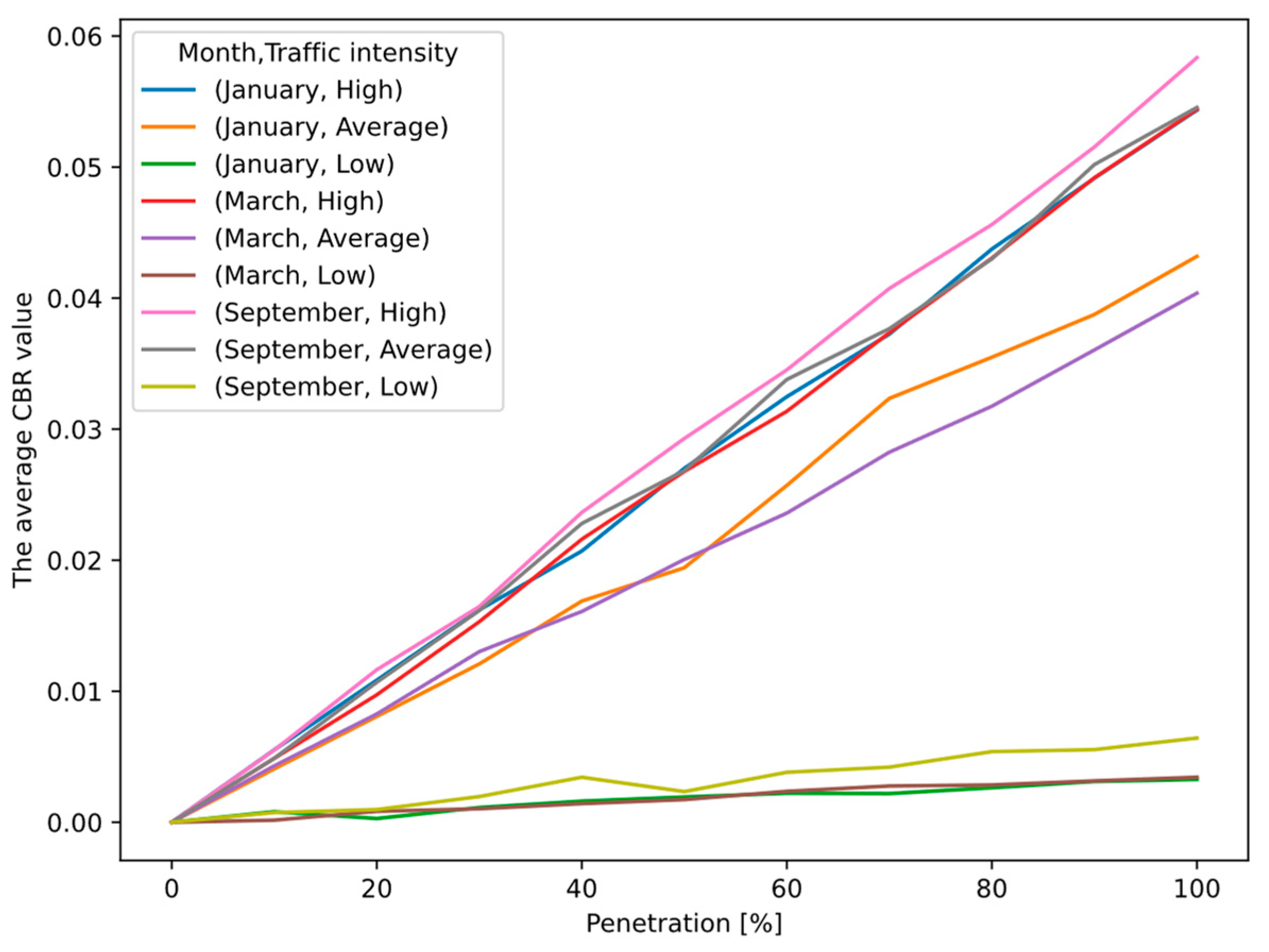
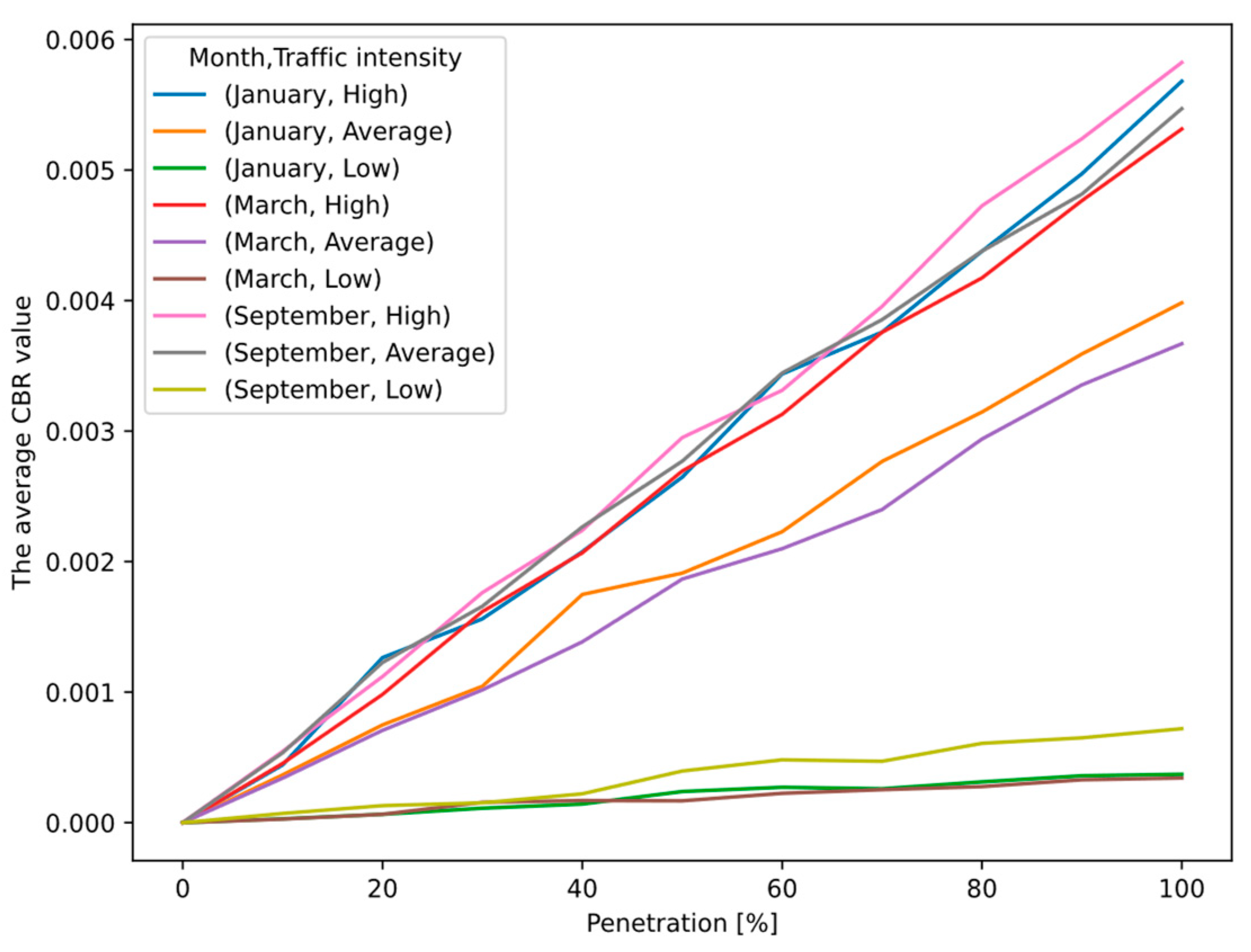

| Use Case | Generation | References |
|---|---|---|
| Forward collision | Day1, Day2 | [12,13,14] |
| Intersection collision | Day1, Day2 | [15,16] |
| Speed advisory | Day1 | [17] |
| Adverse weather | Day1 | [18,19] |
| Dangerous situation | Day1, Day2 | [20,21,22,23] |
| Special vehicle | Day1 | [24,25,26] |
| Stationary vehicle | Day1 | [27] |
| Green light optimal speed advisory | Day1 | [28,29,30] |
| Red light violation | Day1 | [31] |
| VRU protection | Day2 | [32] |
| Collective perception | Day2 | [18,33,34,35,36,37] |
| Cooperative awareness | Day1 | [38,39] |
| Maneuver Coordination | Day3 | [40,41,42] |
Disclaimer/Publisher’s Note: The statements, opinions and data contained in all publications are solely those of the individual author(s) and contributor(s) and not of MDPI and/or the editor(s). MDPI and/or the editor(s) disclaim responsibility for any injury to people or property resulting from any ideas, methods, instructions or products referred to in the content. |
© 2023 by the authors. Licensee MDPI, Basel, Switzerland. This article is an open access article distributed under the terms and conditions of the Creative Commons Attribution (CC BY) license (https://creativecommons.org/licenses/by/4.0/).
Share and Cite
Wippelhauser, A.; Tomaschek, T.A.; Verdes, M.; Bokor, L. Real-Life Traffic Data Based ITS-G5 Channel Load Simulations of a Major Hungarian C-ITS Deployment Site. Appl. Sci. 2023, 13, 8419. https://doi.org/10.3390/app13148419
Wippelhauser A, Tomaschek TA, Verdes M, Bokor L. Real-Life Traffic Data Based ITS-G5 Channel Load Simulations of a Major Hungarian C-ITS Deployment Site. Applied Sciences. 2023; 13(14):8419. https://doi.org/10.3390/app13148419
Chicago/Turabian StyleWippelhauser, András, Tamás Attila Tomaschek, Máté Verdes, and László Bokor. 2023. "Real-Life Traffic Data Based ITS-G5 Channel Load Simulations of a Major Hungarian C-ITS Deployment Site" Applied Sciences 13, no. 14: 8419. https://doi.org/10.3390/app13148419
APA StyleWippelhauser, A., Tomaschek, T. A., Verdes, M., & Bokor, L. (2023). Real-Life Traffic Data Based ITS-G5 Channel Load Simulations of a Major Hungarian C-ITS Deployment Site. Applied Sciences, 13(14), 8419. https://doi.org/10.3390/app13148419






